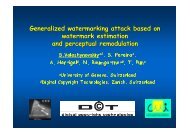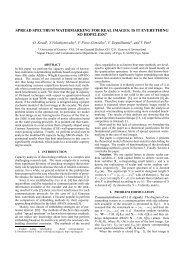Second generation benchmarking and application oriented ... - CVML
Second generation benchmarking and application oriented ... - CVML
Second generation benchmarking and application oriented ... - CVML
Create successful ePaper yourself
Turn your PDF publications into a flip-book with our unique Google optimized e-Paper software.
<strong>Second</strong> <strong>generation</strong> <strong>benchmarking</strong><br />
<strong>and</strong> <strong>application</strong> <strong>oriented</strong> evaluation<br />
S.Pereira, S. Voloshynovskiy, M. Madueno,<br />
S. March<strong>and</strong>-Maillet <strong>and</strong> Thierry Pun<br />
Computer Vision Group<br />
University of Geneva<br />
Computer Vision Group<br />
University of Geneva
Outline<br />
1. Benchmarking state-of-art<br />
2. New attacks<br />
3. New quality metrics<br />
4. Checkmark: Application <strong>oriented</strong><br />
evaluation<br />
5. Conclusions<br />
Computer Vision Group<br />
University of Geneva
1. Benchmarking state-of-art<br />
• Robustness cannot be based on secrecy of the algorithms<br />
(Kerchoff’s principle)<br />
WM embedder<br />
Robustness=f(secrecy)<br />
• Necessity of theoretical <strong>and</strong> practical proofs<br />
WM embedder<br />
Test Tool<br />
• The development of efficient tools for testing WM schemes<br />
is as important as the development of the WM algorithms<br />
themselves.<br />
Computer Vision Group<br />
University of Geneva
1. Benchmarking state-of-art<br />
Deficiencies of Stirmark 3.1<br />
• Not <strong>application</strong> driven<br />
• Inadequate perceptual quality evaluation (PSNR)<br />
• Not enough sophisticated geometrical transformations<br />
• Does not take into account prior information on the<br />
image <strong>and</strong> on the watermark<br />
• Ignores issue of speed at embeding/detection<br />
Computer Vision Group<br />
University of Geneva
1. Benchmarking state-of-art<br />
Classification of attacks<br />
Removal <strong>and</strong><br />
Interference<br />
Attacks<br />
Geometrical<br />
Attacks<br />
Cryptographic<br />
Attacks<br />
Protocol<br />
Attacks<br />
Denoising<br />
Lossy Compression<br />
Quantization<br />
Remodulation<br />
Collusion<br />
Averaging<br />
…<br />
Global warping<br />
Local warping<br />
Global transforms<br />
Local transforms<br />
Projective transforms<br />
…<br />
Brute force<br />
Oracle<br />
…<br />
Inversion<br />
Copy attack<br />
…<br />
Computer Vision Group<br />
University of Geneva
1. Benchmarking state-of-art<br />
Stirmark implemented attacks<br />
• Convolutions filters<br />
• Median filters<br />
• JPEG<br />
• Color Quantisation<br />
• Scaling<br />
• Shearing<br />
• Change of aspect-ratio<br />
• Linear transformations<br />
• Rotation & cropping<br />
• Rotation, scale <strong>and</strong> cropping<br />
• Cropping<br />
• Flip<br />
• Row <strong>and</strong> column removal<br />
• R<strong>and</strong>om Bending<br />
}<br />
HIGH<br />
GEOMETRICAL<br />
WEIGHT<br />
Computer Vision Group<br />
University of Geneva
2. New attacks<br />
Estimation-based<br />
Assumption: WM technology is linear additive<br />
y = x + w<br />
x: Original data<br />
w: Watermark<br />
• estimation of cover data (denoising, perceptual remodulation,…)<br />
• estimation of watermark (copy attack, synchronization removal,…)<br />
Different stochastic methods:<br />
• ML-estimate (local mean, local median, …)<br />
• MAP-estimate ( Wiener Lee,…)<br />
Computer Vision Group<br />
University of Geneva
2. New attacks<br />
Denoising <strong>and</strong> remodulation attacks<br />
(estimation-based)<br />
Marked data<br />
WM<br />
estimation<br />
-<br />
+<br />
+<br />
Attacked data<br />
Mask<br />
estimation<br />
Additional<br />
noise<br />
Scaling factor<br />
Aim at modification of WM using modulation opposite to that used at embedding<br />
Computer Vision Group<br />
University of Geneva
2. New attacks<br />
The copy attack (estimation-based)<br />
Marked<br />
data<br />
WM<br />
estimation<br />
Scaling factor<br />
Target<br />
data<br />
Perceptual<br />
mask<br />
Attacked<br />
data<br />
Computer Vision Group<br />
University of Geneva
2. New attacks<br />
Synchronization removal (estimation-based)<br />
TEMPLATE<br />
Marked<br />
data<br />
Watermark<br />
estimation<br />
F<br />
| · |<br />
Peak<br />
detector<br />
| · |<br />
Interpolator<br />
F<br />
arg<br />
F -1<br />
Affine<br />
Transform<br />
Attacked<br />
data<br />
The basic idea is:<br />
•detect synchronization patterns<br />
•remove<br />
•apply desynchronization techniques.<br />
Computer Vision Group<br />
University of Geneva
2. New attacks<br />
• Non-uniform line removal (r<strong>and</strong>om interval)<br />
• Collage attacks (ex: magazine <strong>application</strong>s)<br />
• Projective Transforms<br />
Geometrical attacks<br />
Attacked data<br />
Simulation of<br />
Record TV screen<br />
x<br />
Record cinema screen<br />
y<br />
Marked<br />
data<br />
2D<br />
z=f (x,y)<br />
Sphere<br />
Cylinder<br />
Wave<br />
…<br />
3D<br />
Geometrical<br />
Transforms<br />
Rotations<br />
Shearing<br />
Scale changes<br />
…<br />
3D<br />
Projection<br />
back<br />
Perspective projection<br />
Parallel projection<br />
2D<br />
R<strong>and</strong>om Bending<br />
Computer Vision Group<br />
University of Geneva
3. New quality metrics<br />
Objective: Take into consideration the HVS!<br />
• Weighted PSNR (global)<br />
• Watson Model<br />
• Local (no. of visible & possible visible blocks,TPE)<br />
• Weight the errors for each DCT coefficient by its<br />
corresponding sensivity threshold<br />
• Sensivity threshold is function of luminance, texture<br />
<strong>and</strong> frequency<br />
Computer Vision Group<br />
University of Geneva
3. New quality metrics<br />
Comparison<br />
• PSNR is greater than 40dB<br />
• Watson metric detects 2 visible blocks<br />
Computer Vision Group<br />
University of Geneva
4. Checkmark<br />
• Partially in the scope of the CERTIMARK European<br />
Project:<br />
http://www.certimark.org<br />
• Contains a set of attacks not yet considered<br />
• Performs better perceptual evaluation<br />
• Introduces the concept of <strong>application</strong>-based evaluation<br />
or <strong>benchmarking</strong><br />
Computer Vision Group<br />
University of Geneva
4. Checkmark<br />
Application <strong>oriented</strong> evaluation<br />
• XML description<br />
• Consider each attack as a function of <strong>application</strong><br />
• Each attack is weighted differently<br />
• Easy to integrate new attacks <strong>and</strong> <strong>application</strong>s<br />
• Automatic <strong>generation</strong> of results as an HTML file<br />
Computer Vision Group<br />
University of Geneva
4. Checkmark<br />
Illustration of <strong>application</strong>s<br />
• MediaBridge<br />
• Passports<br />
• Banknotes<br />
• Copyright protection of images<br />
• Analog<br />
• BW & color newspapers<br />
• Books<br />
• Professional photography<br />
• Digital<br />
• Website<br />
• digital camera<br />
• Maps<br />
• BW & color medical images<br />
• Offline commerce<br />
Computer Vision Group<br />
Defocusing<br />
Denoising …<br />
Slightly geometrical attacks<br />
Copy attack<br />
Medium geometrical attacks<br />
fl Large geometrical attacks<br />
Medium compression<br />
High compression<br />
fl Low compression<br />
…<br />
In general all attacks<br />
University of Geneva
5. Conclusions<br />
• Current Stirmark 3.1 benchmark is inadequate for<br />
evaluating WM schemes<br />
• New <strong>benchmarking</strong> tool Checkmark<br />
• Includes much more sophisticated attacks<br />
• Application based evaluation<br />
• Performs more appropriate perceptual evaluation<br />
CHECKMARK TOOL: http://watermarking.unige.ch<br />
• Open source, Matlab/XML implementation<br />
• Results will be posted <strong>and</strong> software will be available<br />
for downloading in a few weeks<br />
Computer Vision Group<br />
University of Geneva
5. Conclusions<br />
We welcome contributions for:<br />
• New useful attacks <strong>and</strong><br />
• New <strong>application</strong>s<br />
• Submision of XML results <strong>and</strong> related publications<br />
Advantages:<br />
• Common place for results in HTML<br />
• Easy to compare<br />
• Easy to determine strength of algoritms<br />
Computer Vision Group<br />
University of Geneva






